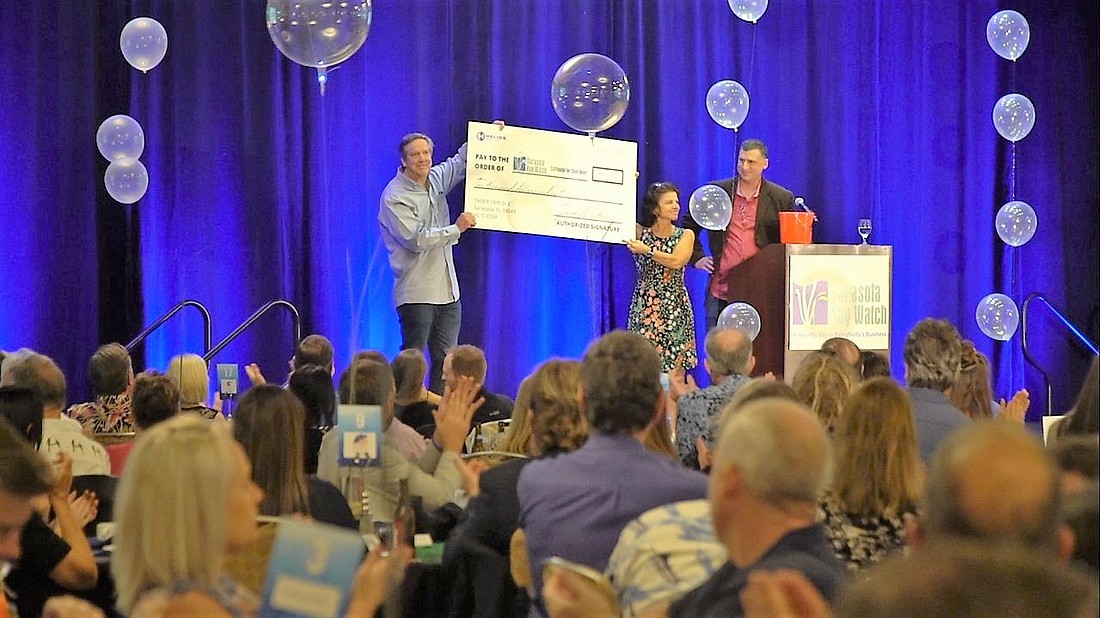- November 27, 2024
-
-
Loading

Loading

Local nonprofit Sarasota Bay Watch hosted its annual Scallopalooza fundraiser event in February where it was presented a $10,000 donation from Helios Technology, which will help fund an ongoing water improvement project involving clams.
More than 400 donors attended and raised enough money to provide 1 million clams for the project. Clams have a natural ability to clean water, which was displayed at each table at the fundraiser.
“We placed a vase of water filled with algae at the center of each table. You couldn’t see through it at all,” said Ronda Ryan, the executive director of Sarasota Bay Watch. “The water was clear in about 30 minutes, and I think that says more than words can.”
The 1 million clams that were made available through the fundraiser will be added to the 875,000 clams already placed in Sarasota and Manatee county waters. Clams can restore waters affected by algae overgrowth, red tide and, perhaps most importantly, a decline in sea grass.
Ryan said clams are only a part of restoring water but play a vital role. Although Sarasota Bay Watch is not a government entity and relies on donations to operate, the clam project has utilized the skills and systems of professionals, including scientists.
“First we have to raise moneym and once we do, we buy the clam seed,” Ryan said. “Then we raise them up and provide them to a clam farmer who waits until they’re about 2 inches long. Young clams are a yummy snack for lots of marine animals, so it’s important to wait until they’re that big.”
Sarasota Bay Watch uses Southern Hardshell Clams which are native to Sarasota-area waters. The areas where they are placed are decided by multiple steps of assessment including fish population and plant-growth history.
In addition to the health and presence of fish, cleaner water would benefit underwater plant life. According to Ryan, when water is murky from algae, plants at the sea floor are unable tor receive the sunlight needed for survival.
“You don’t want to place clams in areas with seagrass, you want to place them in areas that are sandier,” Ryan said. “Hopefully with some luck the seagrass will come later. If you clear the water so that sunlight can penetrate it, you can encourage plant growth.”
Sarasota Bay Watch has also focused on human-caused water pollution through its Marine Debris Retrieval program. One of the top sources of pollution the project has fought is called ghost fishing, where fishing equipment is left abandoned.
Countering ghost fishing has involved action both on land and under water. Sarasota Bay Watch has a team that cleans shoreline and island land of ghost fishing debris, while a team of divers has set debris traps and installing artificial reefs, similar to those created by the Save Siesta Key mini-reefs project.
“It’s clearing fishing gear that was either lost or improperly disposed of,” Ryan said. “We’re talking about crab traps, fishing line and rope. We’re getting that kind of stuff out of the water. It can tangle dolphins, turtles and birds.”
One of the next initiatives Sarasota Bay Watch has is to create an initiative to remove plastic net coverings. With a goal of removing debris such as plastic from the waters, Ryan said pushing for different net coverings is a natural thing to push for.
Ryan said that while Sarasota Bay Watch has multiple projects focused on improving water quality, education on water quality is a very important part of what the organization does. Student volunteers were present at the fundraiser and more are encouraged to join.
“It’s important that we get these young people educated, help them know what the water is supposed to look like,” Ryan said. “We need to do that because when our older population is gone, it will be the younger population’s responsibility. Students are a big art of what we do.”
More information about Sarasota Bay Watch can be found on its website at SarasotaBayWatch.org.